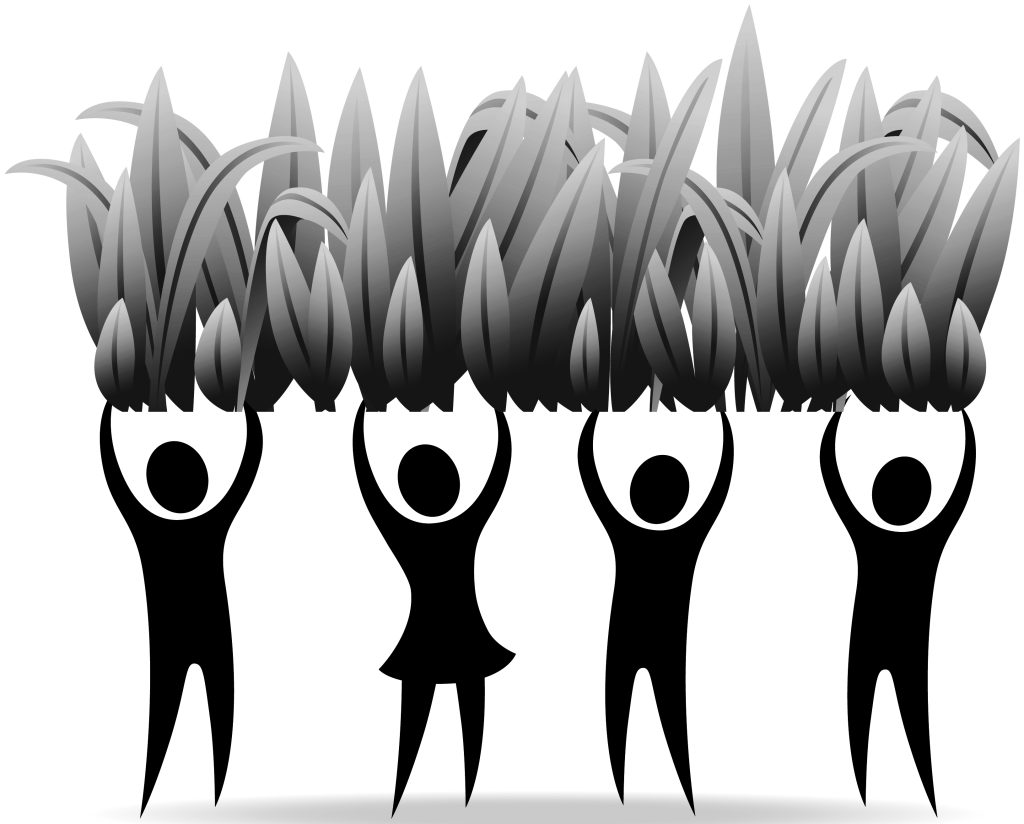
The Stirrer
Every so often, there’s a need to argue why any effective push for radical change has to start at the grassroots, in our communities, and build up from there. In light of some recent, banging my head against the wall ‘discussions’ with supporters of top down movements that seem to spring up out of nowhere, I feel that yet again, there’s a need to make that argument. The fact that I have to keep on writing pieces like this is getting irksome to say the least! However, in the face of some hostility for having the temerity to criticise the likes of Greta Thunberg and Roger Hallam, I feel there’s a need to re-state the case for genuine grassroots led change as opposed to some of the tone deaf, seemingly top down movements that have emerged in recent years.
This piece starts by trying to explain why there’s a growing level of hostility towards ‘movements’ that appear to come down from on high with no discernable sign of organic development and growth. It then goes on to argue the case, as best I can, for building movements for radical change where we live in our communities. Moving on, it looks at the importance of an attachment to community and place when it comes to building any neighbourhood level grassroots project. It then concludes by asking – where do we go from here?
Why there’s hostility towards at least some of the big ‘movements’

I really don’t want to have to start off on a negative note, stating the bleeding obvious. However, the aforementioned ‘discussions’ with supporters of these big movements has left me with no other option, so here goes…
Movements that seem to spring out of nowhere with slick publicity and the ability to make the headlines, albeit often unfavourable ones, will generate suspicion and often hostility from a public that’s becoming more sceptical about the narratives it’s being fed day in and day out. If you don’t understand why the public at large is becoming more sceptical and cynical, may I suggest that a) you start to pay attention and b) you reflect on what has happened over the last three and a half years. If I have to explain what has happened over the last three and half years that you need to be reflecting upon, then sadly, you are well and truly lost!
Alright, I will briefly explain…
Firstly there was the Covid crisis and the massively over the top reaction to that ranging from the lockdowns, the exhortations to ‘socially distance’ and wear masks, then the seemingly relentless pressure to get jabbed with what to all intents and purposes, was an experimental mRNA shot. Then while all of this was going on, the Black Lives Matter (BLM) movement sprung out of nowhere. With protests where for some strange reason, ‘social distancing’ somehow didn’t seem to be as much of a priority. What BLM had to do with long standing, community led fights against racism and police brutality is a question that needs to be answered. It felt like it was something that came right in over the top of these struggles without any meaningful connection with them.
Also seemingly springing out of nowhere were Insulate Britain (albeit briefly) and Just Stop Oil (JSO). These were marked by protests that relied on a lot of theatrics accompanied by brow beating rhetoric. It should be noted that there were a few exceptions where genuinely disruptive, old school tactics were deployed, such as the blocking of a number of oil terminals in Thurrock in the south of Essex. However, they were the exception rather than the norm. You don’t need me to tell you that by and large, the tactics deployed by Insulate Britain and JSO have not gone down well with the public at large! The hostility movements such as JSO get was something I discussed in this piece: A way forward? 20.5.23. Suffice to say that this post did not go down well in some quarters!
Thurrock was the theatre for a number of Insulate Britain and JSO actions. Ones which didn’t go down particularly well with a significant section of the public of Thurrock. Does that mean people in Thurrock don’t give a shit about the environment? If anyone actually thinks that, they really need to give their heads a wobble.
There has been a local campaign in Thurrock and north Kent for a number of years now, fighting the proposed Lower Thame Crossing which would have a seriously detrimental impact on the environment on either side of the river. That campaign is the Thames Crossing Action Group. A campaign that has significant public support. Also, a campaign that JSO somehow never seemed to acknowledge, despite them picking Thurrock as the location for a number of their actions. A locally based campaign with roots in communities on both sides of the Thames enjoys significant public support while JSO who pretty much parachuted into Thurrock attracted considerable hostility. That’s something to think about, isn’t it?
There is some potential…

Note the use of the word ‘some’ in the heading on the previous subsection. While Extinction Rebellion (XR) is another movement that could be seen as coming out of nowhere, they have one major advantage. Namely, they have a network of local groups. Having a local group gives you a connection with the community which you’re based in. It should be noted that down here in Avon, a number of XR groups played a significant role within the Bristol Airport Action Network, a coalition of local groups who fought the proposed expansion of the capacity of the airport. While sadly, the fight to stop the expansion of the airport wasn’t a success, the campaign showed that XR have the capability to develop a strong local base when they put their mind to it.
XR are at a bit of a crossroads at the moment. If they could move away from over-focusing on carbon to dealing with the broader environmental crisis we face while giving local groups more autonomy to decide campaign priorities and tactics, there’s the potential for something interesting to emerge.
Why change has to come from the base

This may be stating the bleeding obvious but, projects and campaigns based in and focused on their locales are undertaken by people living there. That’s people who have a genuine connection to their community and who care deeply about how it will develop into the future. While they may not always enjoy universal support from across the community, they will generally get a lot more support than a group that’s seen to be parachuting in. Even if they don’t get support, because they’re based in and are a part of the community, they will at least get some degree of respect.
Where we live in Keynsham, and in the neighbouring cities of Bristol and Bath, there are a wide range of community based groups and projects, each of which in their own way are striving to make where they’re based better places to live. Some are reactive, having to deal with decades of neglect of their communities, plugging the gaps left by a system that doesn’t care. Others are more proactive, working at ways of localising food production and doing what they can to widen access to fresh, healthy food. Among this range of groups, there are those who genuinely want to change the system but who realise that can only be done by building from the base upwards. A range of these groups and projects are listed in this section on the currently archived Grassroots Alternatives blog: Links.
A project for change at the base will only work if it’s run by and for the community. Projects that are seen to have been parachuted in will not get the legitimacy they need to survive, let alone achieve anything. If a project based in a neighbourhood isn’t owned by the community, perceptions of what it is and aims to achieve will soon turn towards the negative. Most people are pretty sussed and will be able to clock pretty quickly if a project is genuine or has been parachuted in.
For those that have been paying attention, trust in authority is in decline. A decline that was accelerated by the response to the Covid crisis. Not only is trust in authority in decline, trust in movements that seemingly appear out of nowhere is pretty poor. While people are becoming more sceptical of authority and big movements, if they see something in their neighbourhood they can sense is genuine, they will at least come to respect it, hopefully, some will want to become an active part of it.
This is why we support community projects that bring people together, regardless of their backgrounds. At the end of the day, whoever we are and wherever we’re from, we all want to live in a neighbourhood where people look out for and care for each other. A neighbourhood that in an age of failing public services can provide networks of support for its more vulnerable members. A neighbourhood that’s making steps to take control of its food supply with community gardens/allotments, community food kitchens, food buying groups and the like. A neighbourhood that once it gains a degree of self confidence about looking after itself, will start to ask some searching questions about power, who exercises it and how it has to be brought right down to the grassroots.
Why acknowledging attachment, connection and in some cases, spirituality is important

This is something I’ve already explored in some depth in this post: Attachment, connection and a search for meaning 24.11.22. A lot of what we’re about as a project is building a sense of community cohesion and solidarity. A key part of that is having a feeling of attachment and connection to where you live. That’s regardless of where people may have originally come from. Having that is the spur to wanting to get involved in community projects, to make where you live a better place to live. What’s important is that this feeling of attachment and connection applies to the people in your community as well as the location you live in.
It’s about working towards how we should be living. That’s living in a community where people have an attachment and connection to the village, town or city neighbourhood they live in and the people they live alongside. It’s about looking out for each other, building the bonds of solidarity and caring about the locality you live in. It’s about real connections in real life, not fake ones online. It’s the opposite of what the faceless corporations and the governments who do their bidding want for us which is living in an atomised, selfish society where people are actively encouraged to compete with and fear each other. There are many more of us than them though. Whatever they try to do, they’ll never eradicate people’s natural desire for a sense of attachment and connection to place and community.
There’s a spiritual dimension to this as well. When we lose our relationship with nature and the landscape around us, we lose our sense of what is real. Reality is increasingly not what we should be seeing with our eyes and feeling with our hearts. Instead, we’re having a fake reality foisted upon us by the media, an entertainment industry that’s essentially a distraction industry and increasingly, by virtual reality and the looming nightmare of the Metaverse.

What is also under threat is our organic relationship with each other. Relationships that started to change and be fractured by the onset of the industrial revolution which tore our ancestors from their roots and threw them into the hellholes of the factories and the slums. With the advent of mass entertainment, relationships were judged by false ideals we saw on the screen. With the advent of the Net, relationships faced the threat of becoming increasingly virtual. Some have fallen for that, others continue to resist.
We are talking about a crisis of loss…
- The loss of a sense of community and belonging as people have been more or less forced to uproot themselves to move to where the work is.
- The loss of attachment to a place.
- The loss of attachment to a landscape.
- The loss of any sense of a relationship with nature.
- The loss of the familiar in a world that’s changing ever faster and increasingly, in ways we can’t understand.
- The loss of the familiar that will provoke a backlash, trust us on that…
- The loss of certainty and continuity in a rapidly changing and increasingly baffling world.
- The loss of attachment to each other that comes from having to live in a hyper mobile society.
- Now with the Metaverse, AI, ‘work from home’, the loss of any sense of workplace solidarity, replaced with an increasing feeling of isolation and fear.
To conclude this section, any project for radical change has to be based on an understanding that people want roots and connection. Roots and connection come from a sense of belonging to a place. A sense of belonging and attachment to a locale and a community will spur people to do what they can to protect it from any threat, and to make it a better place for everyone to live in. This for me is why change has to come from the base, which is where we live and the people we relate to in our communities.
Conclusion – where do we go from here?

If only I knew the answer to that one! On the positive side, as you can see from this page – Links – there are many groups and projects working away at the grassroots in their communities. Please note that this is far from a comprehensive list and should the Grassroots Alternatives project ever be fully revived, more work will be undertaken to expand it. What it does indicate is that the foundations for the new world we want where people look out for and care for each other and also, where they live, are already in place.
There are however, obstacles. One of those are the divide and rule tactics deployed against us by those who presume to rule over us. Another is the emergence of what can best be described as ‘manufactured movements’ that appear to have very little in the way of an organic base at the level of the neighbourhood. Movements that appear to have a lot of uncritical support from people we hoped would have known better. Personally, I haven’t got the time and energy to spend on showing these ‘movements’ up for what they really are. However, sometimes, I feel I have no choice but to do it. I’d rather expend that time and energy on supporting and getting involved in local projects that make a real difference to the communities they’re based in. In other words, helping to build an example of how things could be if we all pull together at the level of the neighbourhood…